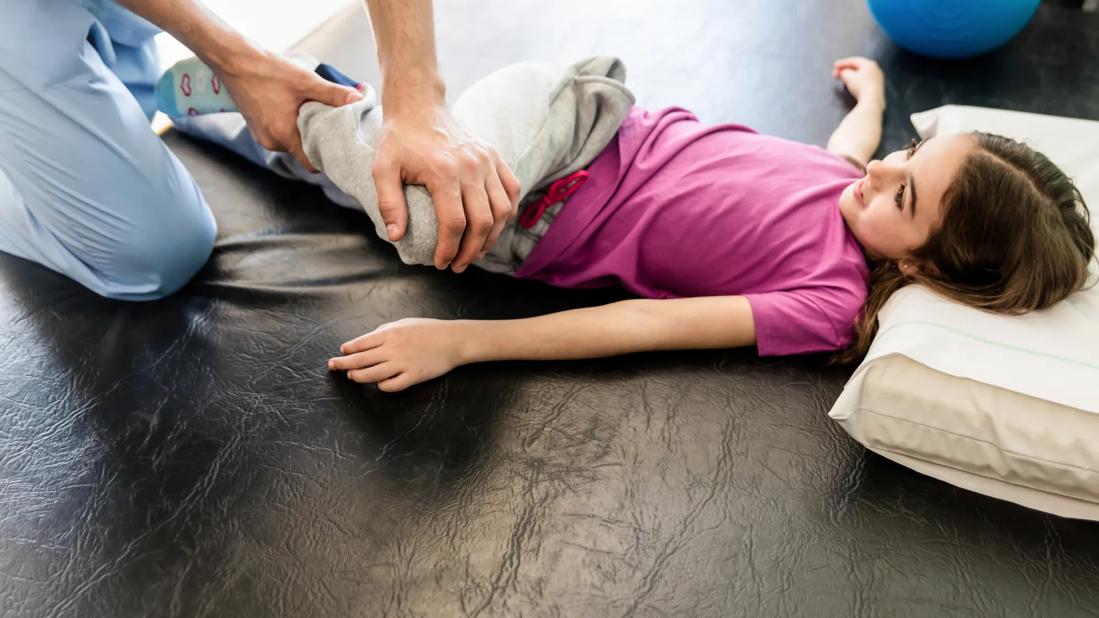Self-efficacy mindset, burst therapy and increased biofeedback may help improve outcomes

Between 11% and 38% of children will experience chronic pain lasting three months or longer. Cleveland Clinic’s Pediatric Pain Rehabilitation Program is one of about 12 programs in the U.S. that offer intensive interdisciplinary pain treatment (IIPT).
Advertisement
Cleveland Clinic is a non-profit academic medical center. Advertising on our site helps support our mission. We do not endorse non-Cleveland Clinic products or services. Policy
“We work with children who have significant functional impairment or disability due to chronic pain,” says the program’s Clinical Director, Ethan Benore, PhD. “We are trying to get them back to functioning independently — helping them get their lives back.”
Research is key to the center’s mission. At the 2023 International Symposium on Pediatric Pain, the program presented four posters highlighting recent pain rehabilitation studies.
All of the studies assessed two types of variables that staff measure when patients are admitted to and discharged from the three-week program (which typically includes two weeks on an inpatient unit followed by one week in a day-treatment program):
The four studies evaluated:
The power of self-efficacy in IIPT. In this retrospective data analysis, researchers considered how self-efficacy — the belief that you can accomplish tough things — is related to functioning and process variables and impacts patient outcomes. There were three primary findings:
Advertisement
The findings reinforced the program’s approach to care. “We have worked to make self-efficacy more central to our approach and how we talk to kids — the way we prompt them, the words we use to discuss their progress and how we reinforce their efforts,” says Dr. Benore. “We want to strengthen the belief that our patients can be successful in their rehabilitation and beyond. They can do hard things!”
“Burst” therapy as an alternative approach to IIPT. The intensity, frequency and duration of traditional IIPT programs may be overwhelming for some patients, such as children on the autism spectrum and those who have endured trauma. Cleveland Clinic conducted a single-subject narrative case study to compare a traditional program to a “burst” therapy format — in essence, replacing multiple hours of therapy per day with two shorter (three-hour) intense therapy sessions, with weeks of time between treatments.
“We found that by doing short intervals of therapy and then having the patient go home and do a little more work themselves, they were able to make progress where they did not in an intensive inpatient setting,” says Dr. Benore. “It opened our eyes to a possible alternative for some kids who aren’t amenable to an inpatient program.”
Increased biofeedback practice as part of IIPT. Thirty-four patients in the program received training on proper breathing mechanics using respiration biofeedback, heart rate variability biofeedback, and asynchronous biofeedback using tools on smartphones and laptop computers.
Advertisement
“We wondered if patients would get better or get better faster if we gave them tools to practice on their own,” says Dr. Benore. “The study showed that children demonstrated some improvement in physiologic functioning over the three weeks they were in the program. Initial data also suggest that those who practice biofeedback more may have greater response to treatment.”
A separate analysis of two patients with vastly different practice patterns revealed that self-administered biofeedback yielded better outcomes than no practice at all.
Why some patients don’t successfully complete IIPT. This retrospective descriptive analysis studied 15 patients who were discharged early from the rehabilitation program. Five patients got COVID-19 or experienced financial issues. The remaining 10, which were the focus of the study, became overwhelmed or refused to participate.
The study revealed that one of the most significant factors related to early discharge was low readiness to change. “There are kids who came into the program because they were suffering, but they didn’t really know what they were getting into,” says Dr. Benore. “Or they came in because their parents signed them up and it seemed OK until they had to go to bed in an inpatient facility.”
In response, the program has initiated motivational interviewing of prospective patients to better understand why children are enrolling in the program, thereby reducing early discharges. In 2023, the center had only three early discharges.
The goal of all of the program’s research is to improve patient care.
Advertisement
“We have been around for 18 years, and we have demonstrated good outcomes, but we are still looking for ways to get better,” says Dr. Benore. “We are doing that by creating innovative programming like burst therapy and biofeedback practice. We also are exploring new opportunities, such as using a self-efficacy mindset to improve outcomes for patients.”
Dr. Benore encourages pediatric providers to consider an IIPT for patients whose pain has persisted for more than three months despite conventional treatment.
“There are some problems that just don’t go away without intensive intervention,” he says. “Don’t wait for months or a year to get help for these patients. We can help. We continue to get feedback from patients years after they graduate our program, letting us know how they are and what they are up to. We are grateful to know that we played a pivotal role in their recovery.”
Advertisement
Advertisement

Researchers seek solutions to siloed care, missed diagnoses and limited access to trauma-informed therapies

Cleveland Clinic study investigated standard regimen

Researchers identify the neurologic evolution of pain-related learning

Tapping into motivational interviewing to guide behavioral change

How functional restoration can help children with these conditions marked by unexplained pain with stigmatized symptoms

Two-hour training helps patients expand skills that return a sense of control

National Institutes of Health grant supports Cleveland Clinic study of first mechanism-guided therapy for CRPS

New technologies and tools offer hope for fuller understanding